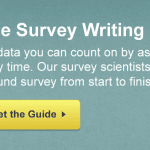We’ve been there—2 a.m. in the library, completely stressed out and weepy because your survey data makes no sense and the deadline for your paper is fast approaching.
Fear not, dear survey creators! We’ve got some A+ tips to take the stress out of your academic surveys this year.
Planning your survey: Be specific and work backwards
Sure, collecting a ton of information via online research surveys seems like a great strategy—better to have too much than not enough, right? While that may be true of your hoard of study snacks, it can be overwhelming to sort through a mountain of survey research data when you’re on deadline.
It’s better if you take a more targeted approach. Start off by setting a survey goal—and determining answer format (multiple choice or open response question types)–so you’ll get out of the library at a reasonable hour. When you begin with the data points (and format) you want in mind, it’ll be easier to design your questions so you’ll get relevant responses.
Planning your survey carefully is especially important if your design needs to be approved by your school’s Institutional Review Board (IRB): You won’t be able to edit it very much once your survey has been been accepted. See how SurveyMonkey helps you adhere to IRB guidelines to ensure your survey gets approved the first time around.
Test your survey questions first
Once your survey is set up, test it. Test it again! Use preview mode to be sure everything is behaving as intended.
Don’t let your live survey be the first time you see what your project looks when it’s full of responses. Test it with a practice collector (like a survey Email Invitation sent to a friend) so that you’re able to tell what your graphs will look like with more than one response. Surprise visits from far-away friends are fun, surprise conversations with your adviser on why the data from your survey research is unusable—less so.
And before you send your survey, make sure you run through our survey scientist’s survey to-do list for survey success.
Keep your respondents awake
If you find your eyes glazed over after taking your survey multiple times, it might be worth reimagining some questions. The better the respondent is able to engage with your survey, the better you’ll be able to use the information you gather to make more informed decisions. Still writing snoozers? Check out how to write surveys that’ll get you the survey data you want. Or peruse our list of survey templates for inspiration.
Collect responses the smart way
Once your survey is all set up, you’re finally ready to connect with your respondents. So you’ve got to choose the best way to send your survey for great results. One big question here is whether or not to track who takes your survey. If your responses need to be anonymous, a quick trip to your collector settings is in order.
When it comes to survey research (and life in general) it’s important to ask for exactly what you want, and nothing less. If you need demographic survey data that you don’t yet have, remember to put a question or two in the survey design.
If you’re looking for respondents that you don’t have access to—say you need 100 nurses living on the U.S. West Coast but you know at most one nurse in real life, SurveyMonkey Audience can get you exactly the respondents you need!
Keep these tools under your belt and you’ll be ready to slay the research paper dragons, one well-crafted survey at a time.




